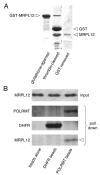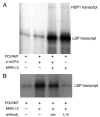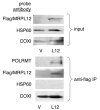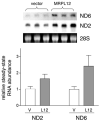Human mitochondrial ribosomal protein MRPL12 interacts directly with mitochondrial RNA polymerase to modulate mitochondrial gene expression
- PMID: 17337445
- PMCID: PMC2606046
- DOI: 10.1074/jbc.M700461200
Human mitochondrial ribosomal protein MRPL12 interacts directly with mitochondrial RNA polymerase to modulate mitochondrial gene expression
Abstract
The core human mitochondrial transcription machinery comprises a single subunit bacteriophage-related RNA polymerase, POLRMT, the high mobility group box DNA-binding protein h-mtTFA/TFAM, and two transcriptional co-activator proteins, h-mtTFB1 and h-mtTFB2 that also have rRNA methyltransferase activity. Recapitulation of specific initiation of transcription in vitro can be achieved by a complex of POL-RMT, h-mtTFA, and either h-mtTFB1 or h-mtTFB2. However, the nature of mitochondrial transcription complexes in vivo and the potential involvement of additional proteins in the transcription process in human mitochondria have not been extensively investigated. In Saccharomyces cerevisiae, transcription and translation are physically coupled via the formation of a multiprotein complex nucleated by the binding of Nam1p to the amino-terminal domain of mtRNA polymerase (Rpo41p). This model system paradigm led us to search for proteins that interact with POLRMT to regulate mitochondrial gene expression in humans. Using an affinity capture strategy to identify POL-RMT-binding proteins, we identified mitochondrial ribosomal protein L7/L12 (MRPL12) as a protein in HeLa mitochondrial extracts that interacts specifically with POLRMT in vitro. Purified recombinant MRPL12 binds to POLRMT and stimulates mitochondrial transcription activity in vitro, demonstrating that this interaction is both direct and functional. Finally, from HeLa cells that overexpress FLAG epitope-tagged MRPL12, increased steady-state levels of mtDNA-encoded transcripts are observed and MRPL12-POLRMT complexes can be co-immunoprecipitated, providing strong evidence that this interaction enhances mitochondrial transcription or RNA stability in vivo. We speculate that the MRPL12 interaction with POLRMT is likely part of a novel regulatory mechanism that coordinates mitochondrial transcription with translation and/or ribosome biogenesis during human mitochondrial gene expression.
Figures





Similar articles
-
Mitochondrial ribosomal protein L12 selectively associates with human mitochondrial RNA polymerase to activate transcription.Proc Natl Acad Sci U S A. 2011 Nov 1;108(44):17921-6. doi: 10.1073/pnas.1108852108. Epub 2011 Oct 14. Proc Natl Acad Sci U S A. 2011. PMID: 22003127 Free PMC article.
-
Transcription-independent role for human mitochondrial RNA polymerase in mitochondrial ribosome biogenesis.Nucleic Acids Res. 2013 Feb 1;41(4):2479-88. doi: 10.1093/nar/gks1447. Epub 2013 Jan 8. Nucleic Acids Res. 2013. PMID: 23303773 Free PMC article.
-
Mitochondrial Ribosomal Protein L12 Is Required for POLRMT Stability and Exists as Two Forms Generated by Alternative Proteolysis during Import.J Biol Chem. 2016 Jan 8;291(2):989-97. doi: 10.1074/jbc.M115.689299. Epub 2015 Nov 19. J Biol Chem. 2016. PMID: 26586915 Free PMC article.
-
Initiation and beyond: multiple functions of the human mitochondrial transcription machinery.Mol Cell. 2006 Dec 28;24(6):813-25. doi: 10.1016/j.molcel.2006.11.024. Mol Cell. 2006. PMID: 17189185 Review.
-
Human mitochondrial RNA polymerase: structure-function, mechanism and inhibition.Biochim Biophys Acta. 2012 Sep-Oct;1819(9-10):948-60. doi: 10.1016/j.bbagrm.2012.04.002. Epub 2012 Apr 19. Biochim Biophys Acta. 2012. PMID: 22551784 Review.
Cited by
-
Relative abundance of the human mitochondrial transcription system and distinct roles for h-mtTFB1 and h-mtTFB2 in mitochondrial biogenesis and gene expression.Nucleic Acids Res. 2007;35(12):4042-54. doi: 10.1093/nar/gkm424. Epub 2007 Jun 8. Nucleic Acids Res. 2007. PMID: 17557812 Free PMC article.
-
Calorie restriction and SIRT3 trigger global reprogramming of the mitochondrial protein acetylome.Mol Cell. 2013 Jan 10;49(1):186-99. doi: 10.1016/j.molcel.2012.10.024. Epub 2012 Nov 29. Mol Cell. 2013. PMID: 23201123 Free PMC article.
-
NAD+-dependent deacetylase SIRT3 regulates mitochondrial protein synthesis by deacetylation of the ribosomal protein MRPL10.J Biol Chem. 2010 Mar 5;285(10):7417-29. doi: 10.1074/jbc.M109.053421. Epub 2009 Dec 30. J Biol Chem. 2010. PMID: 20042612 Free PMC article.
-
Mitochondrial ribosomal protein L12 selectively associates with human mitochondrial RNA polymerase to activate transcription.Proc Natl Acad Sci U S A. 2011 Nov 1;108(44):17921-6. doi: 10.1073/pnas.1108852108. Epub 2011 Oct 14. Proc Natl Acad Sci U S A. 2011. PMID: 22003127 Free PMC article.
-
Ancient mtDNA genetic variants modulate mtDNA transcription and replication.PLoS Genet. 2009 May;5(5):e1000474. doi: 10.1371/journal.pgen.1000474. Epub 2009 May 8. PLoS Genet. 2009. PMID: 19424428 Free PMC article.
References
Publication types
MeSH terms
Substances
Grants and funding
LinkOut - more resources
Full Text Sources
Molecular Biology Databases

